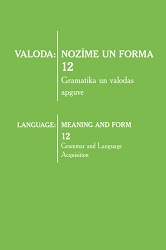A comparison of degree intensifiers across English corpora: IS it ‘flagrant’, ‘blatant’, or ‘sheer’ audacity?
A comparison of degree intensifiers across English corpora: IS it ‘flagrant’, ‘blatant’, or ‘sheer’ audacity?
Author(s): Julija Korostenskienė, Lina BikelienėSubject(s): Media studies, Syntax, Pragmatics, Sociolinguistics
Published by: Latvijas Universitātes Akadēmiskais apgāds
Keywords: intensifiers; corpus; adjectives; collocations; media; academic; newspaper;
Summary/Abstract: Due to its free-adjoining nature, the category of adjuncts is generally viewed as somewhat peripheral to the forefront of grammatical relations. Meanwhile, given the significance of the media in the present world and the ever-growing prevalence of the notion of news values, outlining the criteria conducive to a message becoming news and including values such as negativity, superlativeness, prominence, timeliness, proximity, etc. (Bednarek, Caple 2014), the broad range of linguistic means encoding intensification, thereby foregrounding a given phenomenon, presents a considerable interest. In this corpus study, we focus on three adjectival emphasisers, flagrant, blatant, and sheer, and examine their use in adjective + noun collocations across a variety of English corpora on the Sketch Engine tool (Kilgarriff et al. 2014) in the academic and the news registers: the “British Academic Written English Corpus”, the “Cambridge Academic English Corpus”, the “English Language Newspapers Corpus”, the “Brexit WR Corpus”, and the “English Timestamped JSI Corpus 2020–10”. We also consider the nominal element the adjectives in question collocate with, seeking to provide an account as to their differences in English. The findings of the study may have implications both for language classrooms and for more specialized fields, such as media studies.
Journal: Valoda: nozīme un forma
- Issue Year: 2021
- Issue No: 12
- Page Range: 74-92
- Page Count: 19
- Language: English

